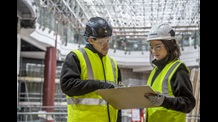Tracking EDI in a hybrid world
2020; the world is thrust into its first global pandemic in a generation and the nation is put into lockdown. Almost overnight, millions of people across the country went from five days in the workplace to none at all. However, for some, including for many in the rail sector, there remained the need to venture out to keep the country moving.
In the construction world, while not without challenges, infrastructure delivery was aided by the sector’s ability to quickly deploy systems enabling remote work. It proved possible to find ways to continue to drive programmes with de-centralised teams. Fast forward three years and we have largely arrived at a collective understanding that hybrid working is here to stay. But what does this mean from an Equity, Diversity and Inclusion (EDI) perspective?
In early 2021, I got a unique insight into how lockdowns (and the associated changes in working arrangements) impacted the EDI sphere. Benefitting from Mace’s proactive encouragement of professional development and cross-sector collaboration, I took up a role (as a rail sector professional) on the National Highways Diversity Leadership Forum. Formed of pan-industry, like-minded organisations, we asked ourselves the question ‘has hybrid working had an impact – positive or negative – on equity, diversity, and inclusion outcomes?’
We surveyed transportation industry professionals to unpack the effects of hybrid working and, while the research is ongoing, the early findings have proven to be a mixed bag.
Positively, in more cases than not, companies have deployed well-intentioned initiatives, such as line manager training to support staff. A shift in corporate language – to encourage hybrid working – has been heralded for prompting a more job applications being submitted from underrepresented groups.
Those with disability challenges and primary care givers – who are statistically more likely to be women – are among those who are now able to consider roles that might have previously felt unrealistic. And people from an ethnic minority background feel there has been a ‘levelling of the playing field’ given the reduced focus on physical proximity and facetime with an increased focus on productivity and quality of output.
But the early results have also highlighted some downsides.
There is an indication that remote working has further exacerbated generational and experiential gaps within organisations. Some of the feedback suggested that line managers still have an unconscious bias, with ‘preferential treatment’ shown to those that visibly ‘go the extra-mile’ by journeying into the office. This underlines the need to widen the lens through which we view and tackle unconscious bias in the workplace; we must acknowledge the influence the pandemic has had on how people think.
So, hybrid working isn’t currently addressing all EDI requirements, but what have we learnt about the measures that will help to redress the balance?
- Getting it right starts with culture. Managers and leaders can set the right culture by pushing the conversation. Take the time to ask deeper questions to get to the bottom of issues - whether that’s in person or on screen.
- Companies should review of the language used in recruitment processes, with a new emphasis on flexible working arrangements (where viable), to ensure the widest pool of candidates.
- Identify moments to review working arrangements. Be adaptable if things don’t work for the individual.
- Harness new technology where it is proven to improve the working arrangements for all colleagues.
- Adopt a consistent approach to performance management by adjusting weighting towards measurement of outputs, rather than inputs. Close the bias gap between a ‘physical career track’ and a ‘digital career track’.
This article was originally published via railstaff.co.uk.











